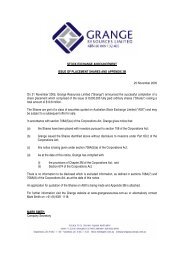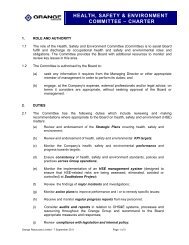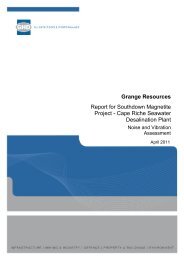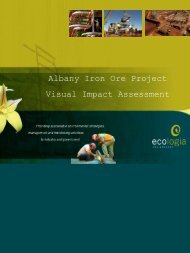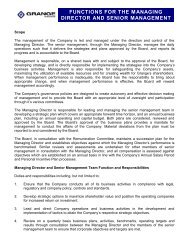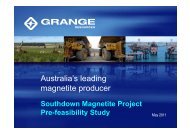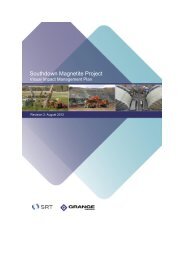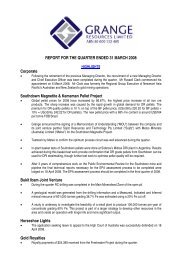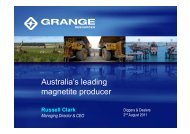2012 Annual Report (2 April 2013) - Grange Resources
2012 Annual Report (2 April 2013) - Grange Resources
2012 Annual Report (2 April 2013) - Grange Resources
Create successful ePaper yourself
Turn your PDF publications into a flip-book with our unique Google optimized e-Paper software.
<strong>2012</strong> ANNUAL REPORT<br />
5<br />
PAGE<br />
Magnetite to Iron<br />
Smelting magnetite to iron involves<br />
agglomeration or ‘clumping together’ of<br />
the magnetite concentrate, and thermal<br />
treatment to produce iron ore pellets.<br />
The pellets can be used directly in a blast<br />
furnace or at direct reduction iron-making<br />
plants.<br />
Magnetite concentrate has internal<br />
thermal energy meaning less energy is<br />
required, compared to haematite, in the<br />
pelletising process which in turn results in<br />
less carbon dioxide emissions. The blast<br />
furnace chemically reduces iron oxide<br />
into liquid iron called ‘hot metal’. The iron<br />
ore and reducing agents (coke, coal and<br />
limestone) are combined. Pre-heated air<br />
is blown at the bottom of the combination<br />
for up to eight hours. The final product is<br />
a liquid which is drained, and eventually<br />
refined to produce steel.<br />
Magnetite Business<br />
Mining magnetite ore is a high volume business. It is capital intensive and requires<br />
significant downstream processing infrastructure including a beneficiation plant, a pellet<br />
plant and port facilities. As can be seen from the following graphic, magnetite products<br />
command a value premium above haematite ore products such as fines and lump. This<br />
premium is derived on two fronts, through additional iron content, and a quality premium.<br />
The growth in Chinese demand, and its understanding of the use of magnetite-based<br />
iron ore products has seen a significant change in the value accrued to both magnetite<br />
concentrate and pellets, and the methodology used for determining that value.<br />
Until <strong>April</strong> 2010, iron ore prices were traditionally decided in closed-door negotiations<br />
between the small handful of “key” miners and steel makers which dominated both spot<br />
and contract markets. Traditionally, the first agreement on price reached between these<br />
two groups set a benchmark price that was followed by the rest of the industry for a<br />
12 month period.<br />
This benchmark system broke down in 2010 with pricing moving to short term indexbased<br />
mechanisms. Given that most other commodities already have a mature marketbased<br />
pricing system, it was natural for iron ore to follow suit. This has seen magnetite<br />
product pricing change so that it is now based on the transparent market based index<br />
prices, with premiums being paid for increased iron ore content and pellet manufacture.<br />
Magnetite – The premium iron ore<br />
Higher<br />
Iron Ore Pellet<br />
~65-69% iron<br />
QUALITY<br />
Direct Shipping<br />
Lump ~63% iron<br />
Magnetite<br />
Concentrate<br />
~67% iron<br />
Direct Shipping<br />
Fines ~58% iron<br />
PRICE<br />
Higher



